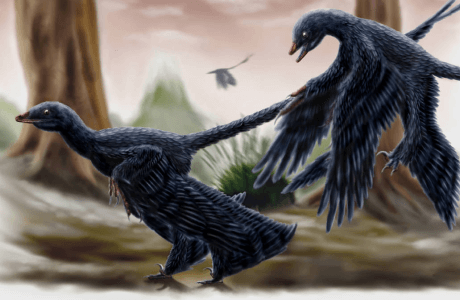Microraptor

A crow-size creature uses sharp claws to scurry to the top of a hundred-foot-tall tree in what’s now northeastern China about 125 million years ago. Looking around for a snack, it spies a small flying critter. The dinosaur, called Microraptor, launches itself from the tree and glides down like a flying squirrel, catching the insect in its small teeth before gracefully landing on a lower branch. Crunch!
Glistening glider
Microraptor, which means “small thief” in Greek, gets its name from being the smallest known species of raptor dinosaurs, or dinosaurs with birdlike qualities. It’s also currently the smallest of all known dinosaurs, weighing about two pounds and only a foot tall. But with a new species discovered on average every week, that could change! This dinosaur had flight feathers on both its front and back limbs, and it had long upper arm bones similar to those seen in today’s birds. It also had a fan of feathers on its tail that it might have used to steer as it coasted to the ground. Scientists have discovered that its feathers were iridescent, meaning they had a metallic shine similar to the feathers of modern peacocks and hummingbirds.
This dinosaur had flight feathers on both its front and back limbs, and it had long upper arm bones similar to those seen in today’s birds. It also had a fan of feathers on its tail that it might have used to steer as it coasted to the ground. Scientists have discovered that its feathers were iridescent, meaning they had a metallic shine similar to the feathers of modern peacocks and hummingbirds.
Fossilized feathers
Scientists can study Microraptor’s feathers because their impressions were preserved in rocks as fossils. But Microraptor isn’t the only feathered glider: Archaeopteryx, another gliding dinosaur, existed about 25 million years earlier, and Anchiornis Huxleyi might be even older.
Dinosaurs with birdlike qualities like these lived alongside other feathered dinosaurs that couldn’t fly at all, like Velociraptor. But the only dinosaurs that survived the asteroid that hit Earth 66 million years ago were avian dinosaurs—birds!
